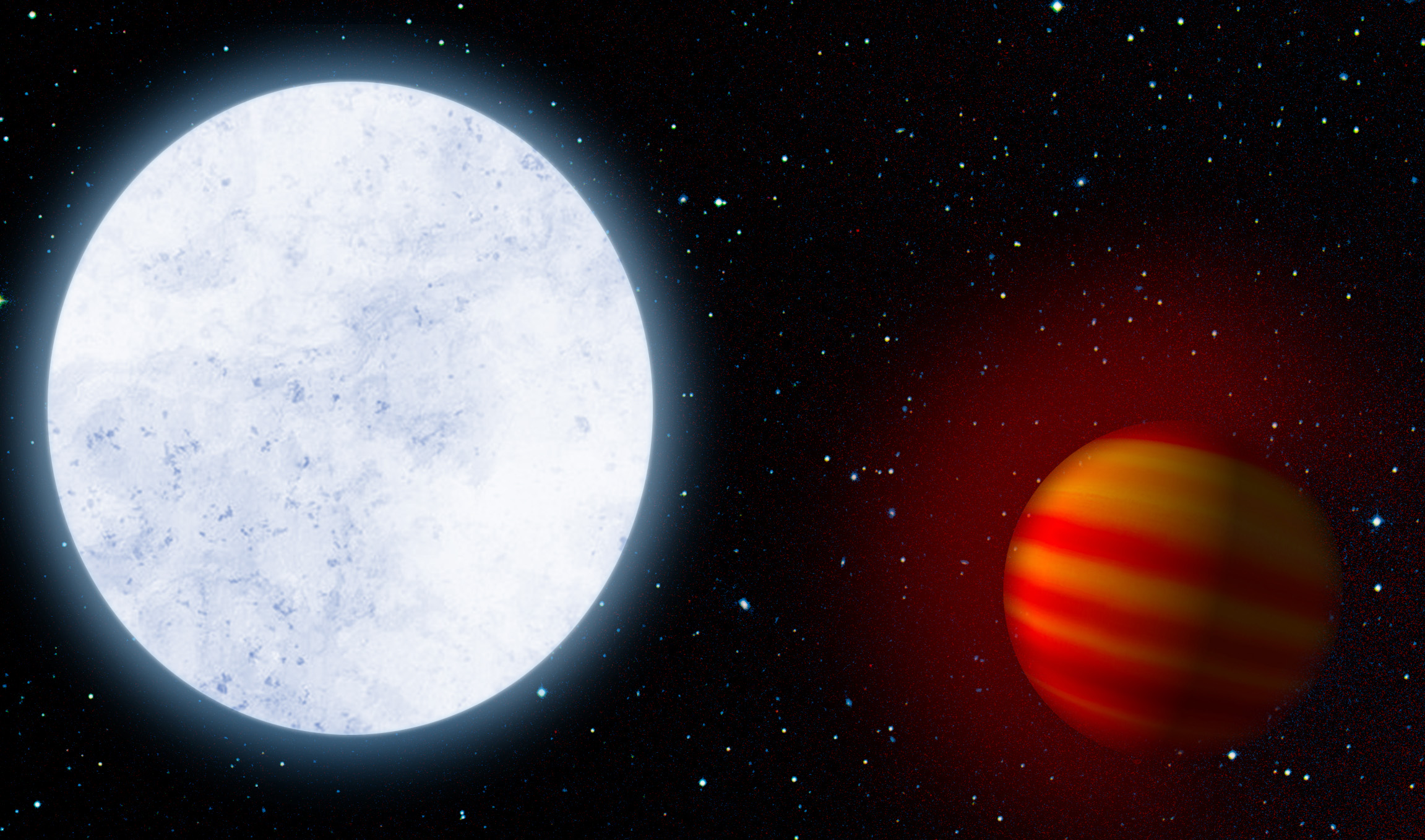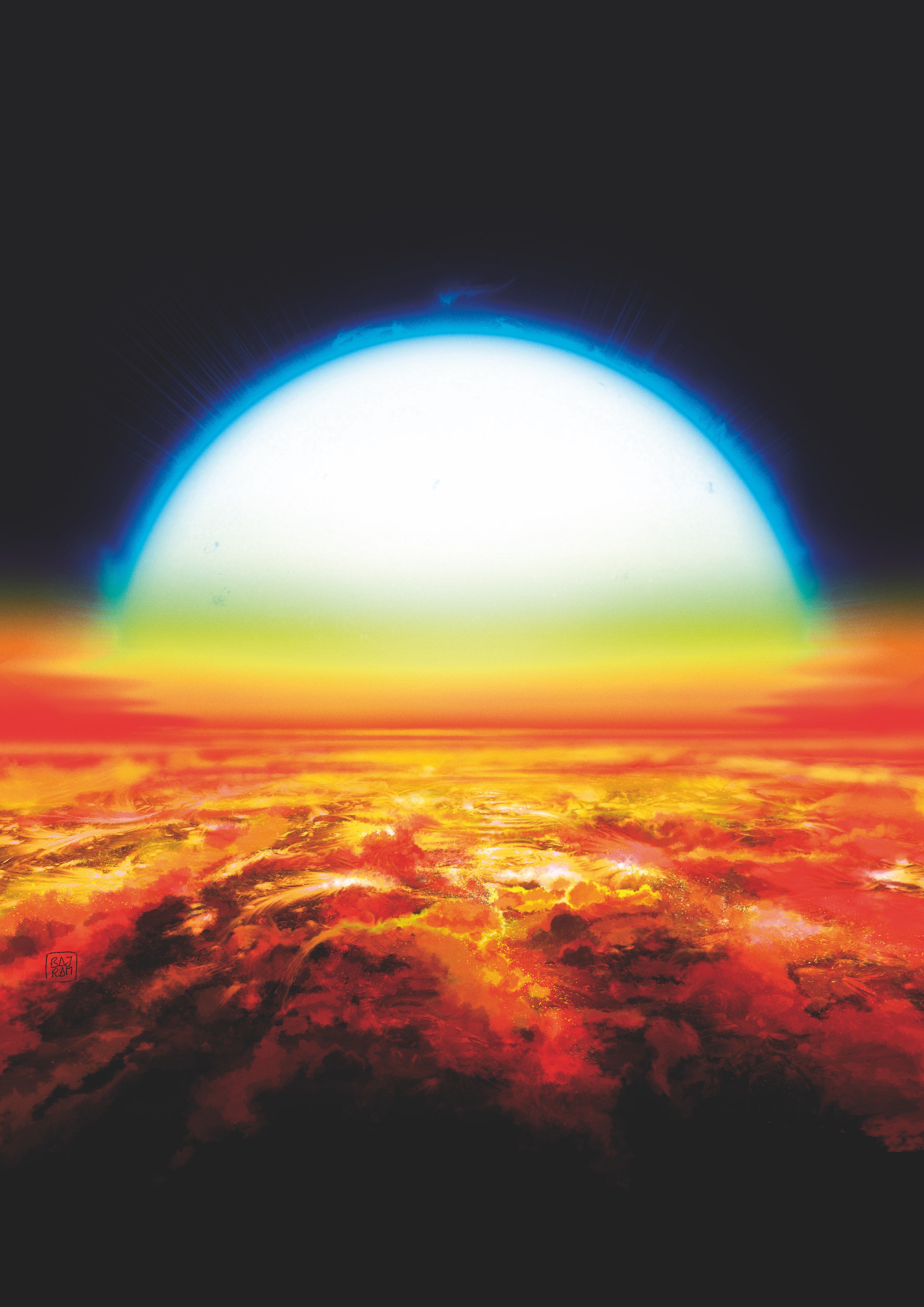Iron and Titanium Found on 'Ultrahot Jupiter,' an Exoplanet First

For the first time ever, astronomers have found iron and titanium in the atmosphere of a planet outside the solar system. The exoplanet, named KELT-9b, is the hottest alien world ever discovered. The planet is so scorching, it's even hotter than most stars.
This sweltering exoplanet, located about 620 light-years away from Earth in the constellation Cygnus, is what astronomers call an "ultrahot Jupiter." KELT-9b is a giant gas world like Jupiter, the largest planet in our solar system. But it's way bigger — it has three times the mass and twice the diameter of Jupiter — and it orbits extremely close to its hot parent star, KELT-9.
"Ultrahot Jupiter" is an unofficial term for a hot Jupiter exoplanet with temperatures exceeding 3,100 degrees Fahrenheit (1,700 degrees Celsius). They "are so hot that they have some resemblance to being stars even though they're planets," Kevin Heng, an astrophysicist at the University of Bern in Switzerland who participated in the study, told Space.com. KELT-9b can reach temperatures of up to 7,800 degrees F (4,300 degrees C). [Gallery: The Strangest Alien Planets]

This record-breaking heat enabled astronomers to detect iron and titanium in KELT-9b's atmosphere. While researchers have long suspected that these elements are present on some exoplanets — iron is one of the most abundant elements in the universe — it's difficult to detect them in cooler environments because the atoms are mostly "trapped in other molecules," Heng said. However, KELT-9b is so hot that the clouds don't condense in its atmosphere, allowing individual atoms of iron and other metals to fly solo.
Titanium has been spotted in an exoplanet's atmosphere before — but not in its atomic form. In September 2017, astronomers using the Hubble Space Telescope announced that they had found titanium dioxide (molecules consisting of one titanium atom and two oxygen atoms) in the atmosphere of an exoplanet named Kepler-13A.
Astronomers can detect different elements by looking at the spectrum of light coming from an object in space. Because the exoplanet doesn't emit its own light, Heng and his team of researchers looked at telescope data collected during a solar transit, when the exoplanet passed directly in front of its star as seen from Earth.
Conveniently, the data already existed before Heng and his co-authors decided to tackle this study. After his colleagues at the University of Geneva used that spectral data to look for hydrogen in KELT-9b's atmosphere, "they actually kept the data in the drawer because there was no reason to search for iron or titanium," Heng said. "Then, a few months ago, we did a theoretical study, which predicted that iron and titanium would be there, and that motivated the search."
Get the Space.com Newsletter
Breaking space news, the latest updates on rocket launches, skywatching events and more!
Using the year-old data from the Galileo National Telescope in La Palma, Spain, the researchers started hunting for metals in the spectrum of light that shone through KELT-9b's atmosphere over a 4-hour-long transit. This data was collected using a spectrograph instrument called HARPS, the High Accuracy Radial Velocity Planet Searcher.

"Different atoms or molecules have a fingerprint when you split the light into a spectrum," Heng said. "Given enough resolution, given good enough data, every molecule has a unique fingerprint." Finding the fingerprints of iron and titanium — elements that Heng and his team already suspected would exist in KELT-9b's atmosphere — would require "a combination of high-performance computing know-how, a careful curation of the spectroscopic databases and meticulous attention to detail," Heng wrote in a blog post on Nature.com.
Heng's team sought the help of Simon Grimm, an astrophysicist at the University of Bern "who is (among other things) an expert in the computation of the opacities of atoms and molecules," Heng wrote in the blog post. "These opacities are not trivial to compute, because one needs to evaluate the strengths and shapes of millions to billions of spectral lines."
Previous studies that looked at hydrogen in the atmosphere of KELT-9b were able to see a strong hydrogen absorption line in the spectrum without doing a more complicated cross-correlation analysis like Heng and his team had to do to find iron and titanium. Astronomers who collected data to look for hydrogen "lacked the theoretical motivation to conduct a serious search for metals such as iron," Heng wrote.
Another study, published July 2 in the journal Nature Astronomy, showed that hydrogen is actually "boiling off" from the atmosphere of KELT-9b and being sucked into the planet's parent star. "It is possible that heavy metal elements are also escaping because the dramatic hydrogen escape can 'drag' heavy elements to very high [in the] atmosphere," Fei Yan, an astronomer at the Max Planck Institute for Astronomy and the lead author of the study, told Space.com in an email.
While the iron and titanium in KELT-9b's atmosphere was a huge discovery, Heng told Space.com that "the technique itself is really exciting" as well. "This is the same technique that we will use to detect signatures of biology, or biosignatures," Heng said. "On Earth, we think it's oxygen and a few other obscure molecules, but we don't know what biosignatures are in general. If you knew what they were … you could use exactly the same technique to detect these molecules in cooler, smaller planets."
It is unlikely that astronomers will find any signs of life on this hellish planet, but Heng and his team have found some other interesting elements in the spectra from KELT-9b. "I don't want to reveal too much, but we have found other metals," he said. "We are also trying to get Hubble Space Telescope time to search for water as well." The goal is to eventually have "a complete chemical inventory of the planet," he said. Hubble will also be able to provide some insight into the weather on KELT-9b. "There should be violent storms on this planet," he said.
The research was published today (Aug. 15) in the journal Nature.
Email Hanneke Weitering at hweitering@space.com or follow her @hannekescience. Follow us @Spacedotcom, Facebook and Google+. Original article on Space.com.
Join our Space Forums to keep talking space on the latest missions, night sky and more! And if you have a news tip, correction or comment, let us know at: community@space.com.

Hanneke Weitering is a multimedia journalist in the Pacific Northwest reporting on the future of aviation at FutureFlight.aero and Aviation International News and was previously the Editor for Spaceflight and Astronomy news here at Space.com. As an editor with over 10 years of experience in science journalism she has previously written for Scholastic Classroom Magazines, MedPage Today and The Joint Institute for Computational Sciences at Oak Ridge National Laboratory. After studying physics at the University of Tennessee in her hometown of Knoxville, she earned her graduate degree in Science, Health and Environmental Reporting (SHERP) from New York University. Hanneke joined the Space.com team in 2016 as a staff writer and producer, covering topics including spaceflight and astronomy. She currently lives in Seattle, home of the Space Needle, with her cat and two snakes. In her spare time, Hanneke enjoys exploring the Rocky Mountains, basking in nature and looking for dark skies to gaze at the cosmos.









